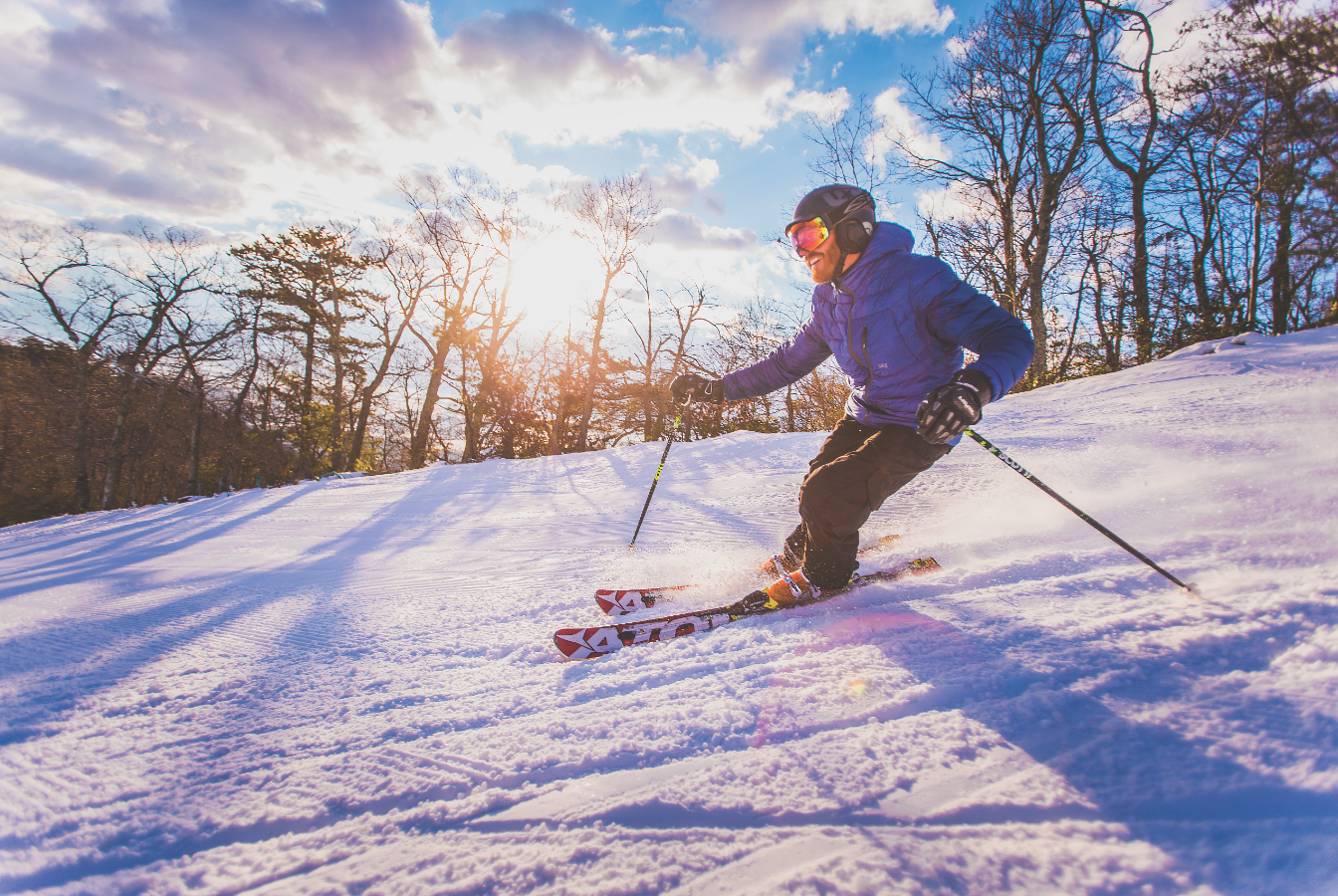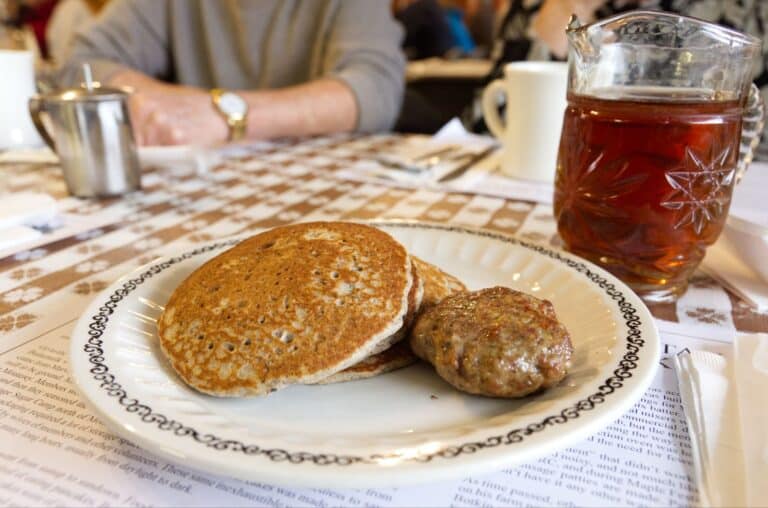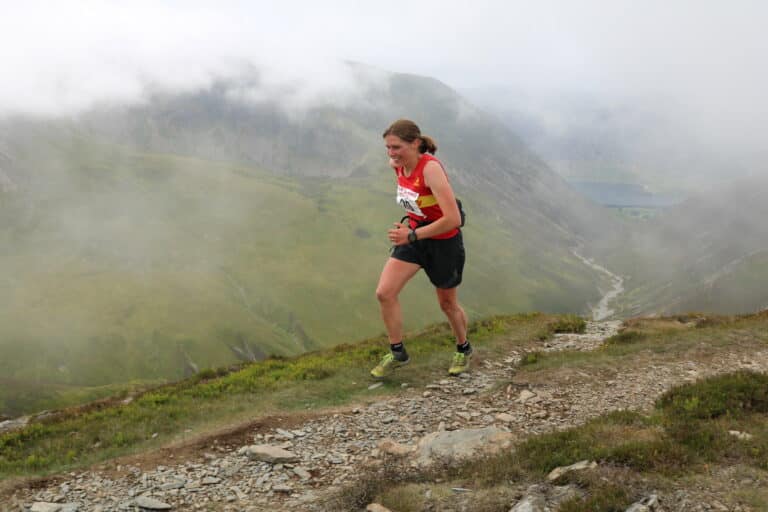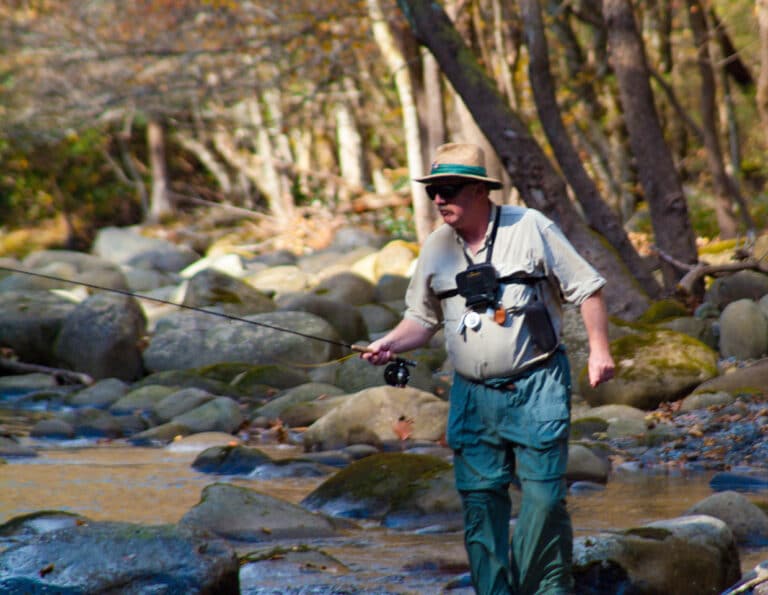Looking for resort fun this winter? Check out these top downhill destinations in the Southeast and Mid-Atlantic.
Best Place to Ski Back in Time
Ligonier, Pennsylvania
Situated in Laurel Mountain State Park in southwestern Pennsylvania’s Laurel Highlands, this one-lift wonder was just opened last year for the first time since 2004. Everything about the resort pays homage to the ski area’s storied past. Enlarged vintage photos from the early 1940s hang in the one-room lodge. The Midway Cabin, an original structure, still stands along the ski runs. Though Laurel Mountain was at one time an exclusive resort for wealthy Pennsylvania families, it has been available for public use since 1964. Come for the cozy feel, the grand mountain setting, and the steep skiing found on Upper and Lower Wildcat. This combined run drops nearly 1,000 feet of vertical pitch, making it the steepest run in the state.
Most Comprehensive Adaptive Sports Program
Wintergreen, Virginia
When Wintergreen ski instructor Michael Zuckerman agreed to give above-the-knee amputee Vince Fiore a lesson in 1984, little did he know that he would pave the way for more than four decades of on-site, specialized instruction tailored to guests with disabilities. Wintergreen Adaptive Sports (WAS) is currently in its 21st year of operation as an independent 501(c)3 non-profit and is housed in its very own facility at Wintergreen. The highly trained and dedicated staff work with students suffering from a wide variety of ailments, both physical and mental, such as multiple sclerosis, spina bifida, hearing/visual impairment, and traumatic brain injury. Each winter, WAS and Wintergreen Resort host a Wounded Warrior Weekend in honor of our country’s wounded veterans and their families. Outside of the snow season, WAS also offers warm-weather adaptive activities like whitewater kayaking and canoeing.
Best Place to Ski the Trees
Snowshoe, West Virginia
Snowshoe Mountain receives an average of 180 inches of fresh pow a year, and at 4,848 feet, backcountry skiers will feel right at home in the spruce-cloaked forests that dominate the resort’s runs. Silver Creek is the most popular spot for skiing the trees with ample moderate terrain and natural features that rival those found in the area’s Mountaineer parks. While the groomed runs might be sparse in freshies, even after a good dump, the tree stashes are often knee-deep throughout, a rare treat in the Southeast.
Best Place to Drop Knees
Timberline Four Seasons Resort
Canaan Valley, West Virginia
Timberline didn’t set out to be a Mid-Atlantic hotbed for telemark skiers when it opened back in 1982, but that’s just what it’s become. The vast majority of its ski school staff and patrollers have been skiing tele since the very beginning, which made Timberline the obvious choice for hosting the annual West Virginia Telemark Festival. The resort even has its own telemark department, with a Facebook page run by the “Nords of Timberline.” The resort, much like its eclectic free-heelin’ patrons, is a destination unto its own. There are no faux Alps-styled houses here, no in-lodge Starbucks or overrun shopping villages. What the resort does have is affordable lift tickets (especially if you’re a local), 1,000 vertical feet, a detailed backcountry trail system that links Timberline with neighboring Canaan Valley Wildlife Refuge and Dolly Sods Wilderness Area, and a slopeside pub. It’s a tele skier’s paradise.
Most Epic Snow Tube Park
Canaan Valley Resort State Park
Canaan Valley, West Virginia
Don’t knock it till you’ve tried it. Flying down a snow-covered hill in an inflatable tube will bring out the kid in anyone, especially if that hill comes in at a whopping 1,200 feet long. Canaan Valley’s snow tube park is one of the resort’s newer additions and ranks as the longest snow tube in the Mid-Atlantic. There’s a magic carpet that effortlessly hauls you back to the top of the hill, and an outdoor fire ring outside the warming hut should the elements start to take their toll. It’s everything we love about skiing the mountain, but with minimum coordination required.
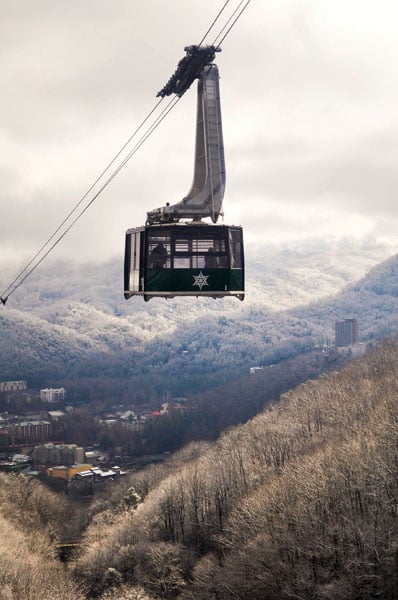
Most Like a European Resort
Gatlinburg, Tennessee
You don’t need a vacation to the Alps to get the mountain tram experience. Ober Gatlinburg’s 2.1-mile cable car is one of just a couple dozen tramways in the country. The tram starts in the quaint yet vibrant downtown sector and rises above the treelines, allowing guests to witness first-hand the sheer scale of the Great Smoky Mountains. While some of the bigger resorts out west have long hauled their guests up the mountain via tramway, Ober’s cable car is the only one of its kind in the Southeast.
Best Resort for Beer Lovers
Beech Mountain, North Carolina
Western North Carolina’s craft beer scene has exploded in the past five years with Asheville in the limelight, but about 100 miles northeast of that southern metropolis, Beech Mountain Resort is quickly making a name for itself as one of only a few resorts brewing its own beer on-site. Beech Mountain Brewing Company started in 2014 with enough capacity to brew 100 gallons per day. This season, the brewery is doubling that capacity and revamping its slopeside taproom to include a viewing area where customers can watch the brewing action. The brewery’s flagship beers include the Beech Blonde Ale, 5506’ Pale Ale, Patroller Porter, and Wee Heavy Scotch Ale. Grab a beer after a long day on the mountain or make a midday pit stop at Skybar 5506’. For now, the resort is the only location where you can indulge in Beech Mountain’s beer, but the beverages should be making their way off the mountain in the years to come.
Most Student Friendly Resort
Blowing Rock, North Carolina
Just five miles from downtown Boone, N.C., and Appalachian State University, Appalachian Ski Mountain can feel a little bit like a frat-boy party come spring break, but it’s that youthful atmosphere, social media savviness, and smokin’ good deals that make this resort such a success with the younger crowd. App Ski Mountain offers $10 Sunday night lift tickets the first Sunday of every month, starting in December, and $20 night sessions for students Sunday thru Thursday (tip: buy online for an extra hour of slope time). If there’s a snow day and you’re a student or teacher at any school system in North Carolina, Tennessee, or Virginia, head to the mountain and pay only $10 for an eight-hour ticket. All you need is a report card, school ID, or paystub to prove your school affiliation.
Best Resort for Post-Work Laps
Wolf Ridge Ski Resort
Mars Hill, North Carolina
When townies from Asheville or Johnson City are jonesin’ for a weekday winter escape, they need only drive 45 minutes to Wolf Ridge Ski Resort, the little ski area that could. Its central location off I-26 is a low-key haven for western North Carolina and eastern Tennessee. When the snow falls, the runs here are some of the South’s steepest and finest. If you “dare to ski the Wolf,” lap The Bowl till your legs burn.
Best Resort for the Kiddos
Cataloochee Ski Area
Maggie Valley, North Carolina
Even though nearly a quarter of Cataloochee’s terrain is considered expert level, this resort knows how to get ski newbs schooled up and on the slopes in no time. Each January, Cataloochee offers a $59 beginner’s deal, Monday through Friday, which covers the cost of a lesson, lift ticket, and rental. For parents with young children, the resort sweetens the pot even more with kid-specific full-day ($125) and half-day ($95) programs as well as four-week afterschool sessions ($125 for four 180-minute lessons). Once the kids are older, they can take part in the resort’s active middle and high school racing program, which hosts races every week.
[nextpage title=”Read on!”]
NEWS ON THE SLOPES
Resort updates and developments for the 2017-2018 snow season.
Fourth And Fifth Graders Ski For Free At Pennsylvania Resorts
For the 14th year in a row, any and all fourth and fifth grade students can ski or ride for free through the Pennsylvania Ski Areas Association (PSAA) Snowpass program. The program costs $40 upfront but then allows students in these two grade levels to ski or snowboard for free throughout the season and at any one of PSAA’s 19 resorts when accompanied by a paying adult. Kids can visit each resort a maximum of three times and their pass include lifts, lessons, and rentals.
For more information, visit www.skipa.com.
Seven Springs Revamps North Park
With the addition of a 900-foot string of nine snowmaking towers, Seven Springs’ North Park is bigger and better than ever. The area has been undergoing renovations all summer and is now a boardercross-style freestyle area complete with small to medium features and banked turns.
Massanutten Puts In A Pipeline
The 6,000-acre resort just expanded its water storage by 50 percent, thanks to the construction of a two-mile-long water pipeline. The project has taken nearly a year to complete, but with the additional updates to its snowmaking equipment, the resort is ready for winter.
Bryce Resort Gears Up For Winterfest
Held each year on the second Saturday of March, Winterfest is a slam packed weekend full of pancakes, costumes, pond skimming, a polar plunge, and even an ice bar.
Beech Mountain Resort To Celebrate 50th Anniversary
Beech Mountain Resort is full of superlatives—it’s the highest resort, located in the highest town, with the highest ski bar in the Eastern United States. This winter, they’ll celebrate 50 years of all of that January 20-28, 2018. Season-long promotions include $9 Ladies Night every Tuesday and $9 Men’s Night on Wednesdays. Couples ski for $24 total on Thursday nights.
Lees-McRae College To Offer Ski Patrol Course Through Beech Mountain
Lees-McRae College’s Outdoor Recreation Management program and Beech Mountain Marketing Director and Lees-McRae alumna, Talia Freeman, are partnering to offer a 3-credit-hour National Ski Patrol Certification Preparation course as well as a Ski and Snowboard PSIA-AASI Instructor Certification Preparation course this spring.
[nextpage title=”Read on!”]
THE SKI PATROL DIRECTOR
Gil Adams
What was your first memory of skiing at Beech?
My parents came up to Hound Ears, which had a ski resort at the time, and they learned about a development planned nearby for Beech Mountain that would be centered around a ski resort. My parents purchased a lot on Beech Mountain and became charter members to the Carolina Caribbean Club (or CCC, the then-owners of Beech), which included complimentary skiing for the first season. That was the winter of 1967-68.
How would you describe Beech during the ‘70s?
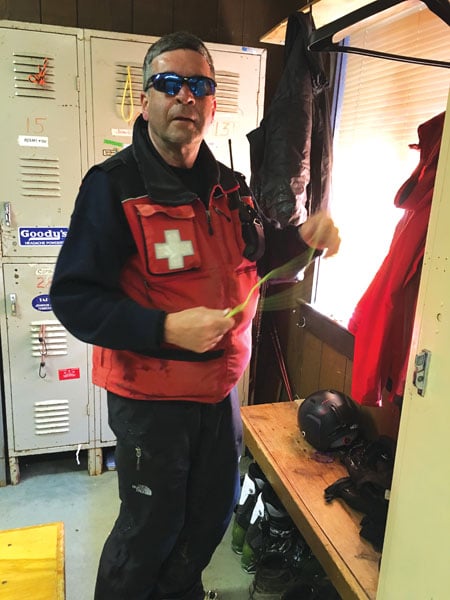
Beech Mountain at the time was a brand new resort. There was a monorail that circled through the parking lots and came up into the village. The lifts were originally a two-person gondola. It was magical, absolutely incredible, especially as I was just a young teenager at the time.
Word on the street is your job responsibilities at Beech have even included delivering babies?
That baby delivered itself! Back in the early ‘70s, the administration building now was a 7-Eleven. We were getting ready to close down for the night and someone called me from the market and said there was a woman in labor. Her family had run over a rock with their car and popped a hole in their radiator and they were stuck. I commandeered a sales vehicle and put the expecting woman in the car, slammed the car in reverse, and then heard the girl say, “It’s coming, it’s coming!” I jumped out and sure enough that baby delivered itself. There were no complications.
You’ve been at Beech for 47 years now, almost since the resort’s beginning. What’s kept you on the mountain for so long?
When I first started ski patrol, I was young and people were always wanting to go to the Rockies to ski patrol. I’ve been there so many times, and it is great skiing, but where we are in North Carolina, it’s just such a beautiful place to be all year long and to me, the ski conditions at Beech Mountain can be as good as anywhere. Every single day I have a view and every single day it’s different. It’s a beautiful place to live, period.
THE MOUNTAIN’S BREWMASTER
Sean McCoy
Brewing beer for a living seems pretty dreamy. How’d you land that sweet job?
I went to Lees-McRae College and got a bachelor’s in communications arts. I didn’t even like beer until I graduated from college and someone gave me a craft beer. A friend of mine, Billy Smith, was the original head brewer at Beech. He piqued my interest as to how craft beer is made versus regular beer. I started with one-gallon stove top brews, then got a little bit better and started growing, doing three- and five-gallon batches. We’d bounce ideas and techniques off each other, and when he moved to Morehead City, N.C., to open up a brewery down there, I took over.
What’s your favorite type of beer?
I personally like hoppy beers, so I tend to experiment with a lot of IPAs and pale ales.
Have you ever had a brewing experiment go horribly wrong?
When I was still home brewing, I had always wanted to incorporate lavender into a beer. I really enjoy that aroma, but I definitely made a perfume bomb. When people say ‘less is more,’ when it comes to using lavender, they definitely mean it. I thought it would transfer well but it was very reminiscent of old lady perfume and needless to say, I haven’t tried that again.
When you’re not brewin’ up a new batch of Beech beers, are you skiing or riding?
I prefer to board. I tried skiing once as a kid. It was horrible. If you’ve ever seen bloopers on what not to do skiing, yeah that was me. I’m extremely uncoordinated and for whatever reason snowboarding was much easier for me.
THE HONORARY LOCAL
Greg “El Redman” Redelman
Canaan Valley Resort State Park, W.Va.
You’ve visited the Valley nearly every weekend of every winter since 1986—what was the experience that got you so hooked?
I learned to surf in Hawaii when my family lived there. I was in seventh grade and I wanted to have a remote control car, that was my hobby, but as soon as I saw the ocean, I was hooked on surfing. But then we moved back here and settled in Fairfax. My PE class offered skiing, and that was kinda cool, but I yearned to be on a surfboard. It wasn’t until ’85 when I went to Canaan to go skiing that I saw a lone boarder at Timberline. I rented a board from Fairfax Surf Shop the next year and stayed at a rental at Timberline during a snowstorm. The deep snow kept me from getting hurt and by the end of the first day I was doing White Lightning top to bottom.
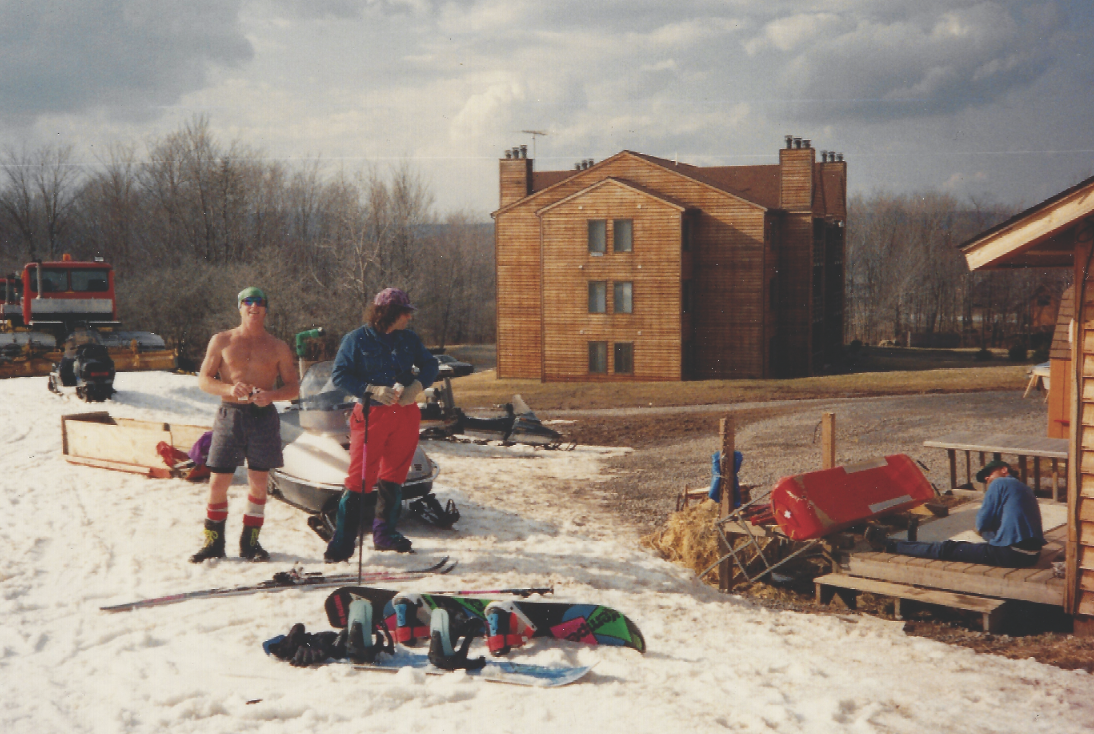
What’s changed in the Valley since you first started riding here?
Well, it used to be 169 miles from my house and it took 3.5 hours. Now it’s 154 miles door to door and the week before last, it took me 2.5 hours. The route now is straight and safe and there are no 10% hairpin turns.
Your surfer style of riding has inspired many local Valley kids to pick up snowboarding. So what’s your signature move?
Frontside 360 on the wall. There’s a specific spot at Canaan that’s perfect for it and I do it every single run.
What’s been your hairiest accident on the slopes?
Early on, I was at the bottom of White Lightning (at Timberline) and I hit a patch that sent me sailing into the woods. The board I had was super old and stiff. I slid feet-first in between two trees and my left foot busted through the board but my right foot didn’t. My board didn’t snap and it pushed my femur back into its socket. I spent a month in the hospital in traction.
Any memorable shenanigans?
Canaan had a pond near where the beginner area is, and it’s a really steep nose section that comes off of there. [Brian] Sarfino and I rode that line and screamed across the frozen pond. Next thing you know, it’s like the small town cop that has someone race by him—donut flies and coffee spills in his lap as he starts chasing down the speedracer. Management flew out of the office and dragged us into the lodge. They gave us the third degree and almost kicked us out. It was kinda funny.
THE JACK-OF-ALL-TRADES
John Lutz
Canaan Valley Resort State Park and Timberline Four Seasons Resort, W.Va.
When did your love affair with winter begin?
I was born and raised in Parkersburg, W.Va., and it didn’t snow all that much in Parkersburg but I just loved snow and I loved winter. I skipped school in grade school whenever it snowed. I would go to great lengths to be outside in the winter. The snowier and colder, the better. And even though I loved winter that much, I didn’t ski until I went to Georgetown University for pre-med in 1964.
Pre-med? So were you a doctor during the day, ski bum by night?
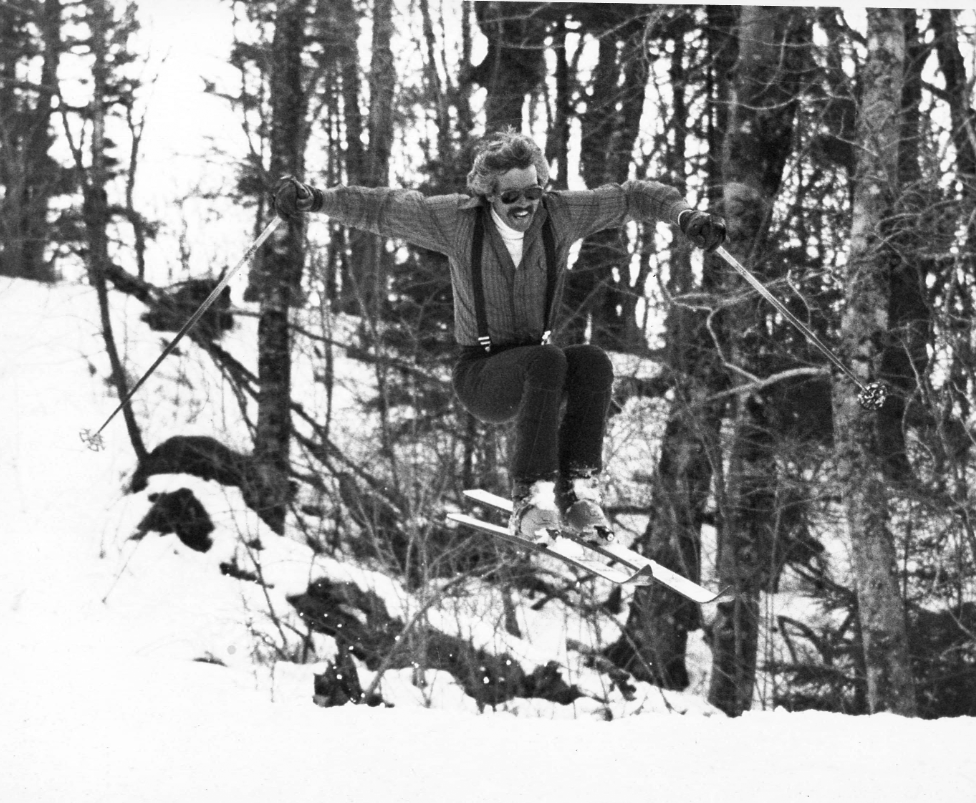
Oh, no, I didn’t pursue pre-med at all. It was obvious I wasn’t going to be a doctor. All I wanted to do was be in the ski industry. I ended up with a degree in economics.
You were with Canaan Valley Resort State Park and Timberline Four Seasons Resort from their first years until 2015—what were some of the roles you filled over all of those years?
I’ve done everything: snowmaking, instructor, ski school director, race director, certified instructor, level 2 race coach, risk awareness and safety director, director of program events, ski area manager. There’s not a whole lot that I haven’t done in the ski business. I still work at both Canaan and Timberline on a consulting basis.
What is special about West Virginia’s ski scene?
There is quality skiing in this state and my main goal in life, other than my family, was to make skiing in West Virginia better. Because it’s West Virginia, it’s a unique state in and of itself, but mostly the people make the place. They’re friendly and ready to have a good time and work hard. In the ‘70s it was just a small core of us locals but the energy was tremendous. There wasn’t a whole lot else going on in the area compared to what is available today, but hell we just got by with what we had because we believed in West Virginia skiing and we worked hard to make it as good as it could be.
What was skiing at Canaan like back in the early days?
Canaan would get really packed. We were doing up to 3,000 skiers a day, which, for a little ski area, that was really busy. There were times it looked like a refugee camp there were so many people there. I remember seeing the overflow from the cafeteria, and there were three people sitting under the payphone having lunch. From then on we always called that a three-top. Some winters, particularly ‘76/’77 and ‘77/’78 , it snowed so much you could barely get around anywhere. People were skiing about any place you could get a pair of skis through.
If you had one last day of snow to ski, where would you go?
Either White Lightning at Timberline or a pipeline right-of-way with fresh snow on it.
THE SKI BUM PARAMEDIC
Tom Kotarsky
Timberline Four Seasons Resort, W.Va.
 Most people come to Tucker County for the skiing, but you didn’t. How did you end up as Timberline’s Ski Patrol Director?
Most people come to Tucker County for the skiing, but you didn’t. How did you end up as Timberline’s Ski Patrol Director?
I started racing mountain bikes and working in the bicycle industry in the late ‘80s. I moved to Davis from Morgantown in 1992 and started working for Matt and Gary at Blackwater Bikes. They were ski patrolling at Canaan Valley in the winter, so in ‘92/’92 I got my ski patrol certification and worked there until I moved to Timberline in ’96. I’m a paramedic for Randolph County, and I think I’m Ski Patrol Director at Timberline basically because I’ve just been there too long.
As patrol director, what’s your biggest pet peeve?
People running off with our signage. It happens all the time. Stop taking our signs people! I swear when I bought my house there was one of our little plastic discs in there. I was at the Honda motorcycle shop not long ago and, I think it was the owner, but this guy had one of our signs on the front of his license plate that said “not groomed.”
What is your on-mountain philosophy?
Skiing is an expression of freedom and I don’t think patrol should be pigeonholing people into you can only do this or that. Why? As long as they’re not running into other people, go out and hurt yourself all you want. I’ll pick you up. Just don’t hurt anyone else.
What’s the most memorable winter you’ve had?
Winter of ’96, Fat Monday. We got 50 inches of snow on a Monday and Canaan shut down. Timberline opened late and everybody was there. I got on the first lift with Chip Chase and, well, you imagine what that was like. The snow was so deep you had to basically track your way to a steep part, then once you got to the steeps you could go down, but it was difficult to even move around in that stuff. I’ll never forget skiing down through the glades and passing deer. They could barely move too, and we would come down through the woods and ski right by them.
THE GUEST-TURNED-GM
Chris Plummer
Do you remember your first time skiing at Laurel Mountain?
It was the late ‘80s. I had just started skiing and snowboarding. My family would always go to Seven Springs and Hidden Valley, but one day we ventured over here [to Laurel Mountain] on a whim. I was overwhelmed at the terrain. I was young, maybe 15 or 16, and a decent skier, but it was unlike anything I’d seen in Pennsylvania before.
How is Laurel Mountain different from Pennsylvania’s other resorts?
The length of the runs and the continuous flow, especially on Upper and Lower Wildcat with almost 1,000 feet of vertical pitch, is something you find in the Adirondaks. In our mountains here in the Mid-Atlantic, we’ll usually have some good steep pitch but then some slower, flatter plateaus. I think that and the atmosphere and history that surrounds it is what makes it completely unique. You’re not getting off an exit on a four-lane highway and passing 1,400 condos on your way to this resort. It’s easy to get to but you’re going up a two-lane road into a state park and the first thing you see isn’t a Starbucks; it’s the big mountain view looking west toward Pittsburgh. It’s a place that really brings you back to the roots of New England skiing and that’s hard to find anywhere in this country I’d say.
How did that 15-year-old starry-eyed teenager end up as Laurel Mountain’s General Manager?
I lived in Lake Tahoe for 10 years but came back to the area to work at another resort in the Laurel Highlands. I jumped into the industry day one out of college and had always wanted to come back to Seven Springs because it’s home. When this opportunity came up, I personally moved my family to Ligonier, Penn., and we live there now and fully embrace the entire atmosphere and everything that is Laurel Mountain.
How is the Laurel Mountain today not unlike the Laurel Mountain of the 1940s?
When we started plans for renovation last summer, we looked at the walls of the lodge and everything that went into the craftsmanship of that building and we decided we weren’t going to touch it. We were going to fix it, but not change the bones of that place. We paid 100% respect to the history. The buildings here tell the story. You can feel it. It hasn’t lost that nostalgia for the heart of skiing. There’s a very unbelievably strong community up here that has been a part of the Laurel Mountain culture from the beginning and that still keeps the story alive and detailed and logged.
THE MOTHER OF TELE
Terry Peterson
Adventuresports Institute, Garrett College, Md.

What was your very first experience with a pair of telemark skis?
I was in school at James Madison University, dating a guy that worked at White Grass Touring Center. For my kinesiology class, I had to study a particular move in a sport and take a quarter of the body and tell what every muscle was doing in that move. I decided to do a telemark turn, and I had never done a telemark turn in my life, so my boyfriend would jump up and down doing telemark turns on the living room floor.
How did you learn to telemark ski?
I come from a cross-country background, so it’s just what I do. There wasn’t anything called a telemark ski back then. They were just cross-country skis in 1983, and you went to the downhill area and fell until the bruises were so big you couldn’t take it anymore. We were in bowling shoes, little leather shoes. You had to be really creative with the gear. We were all just taking the little skinny skis we had, strapping on some old bindings, and cutting plastic cups to give our boots a little bit of support. There were all kinds of homemade high boots back then. Everybody just said, “Follow me. You’ll be a good skier once you stop falling.”
Is telemark skiing a dying sport and if so, why continue teaching it?
Telemark may have seen its heyday, but I don’t think it’s disappearing anytime soon. It’s grown into an industry of its own with its own magazine, its own equipment, where before it was just a turn that you could do so long as your heel wasn’t locked down. Alpine touring (AT) equipment has become so light and so popular, I think a big portion of that market would have gone to telemark had AT technology not improved so much. But telemark is still one of those things that’s hip, that’s cool. My students at Garrett aren’t going to get a position teaching telemark skiing necessarily, but the class really allows them to build their confidence. I’ve never had to cancel a telemark class due to low enrollment.
Hardest part about learning tele?
Understanding and being able to effectively use the back foot.
